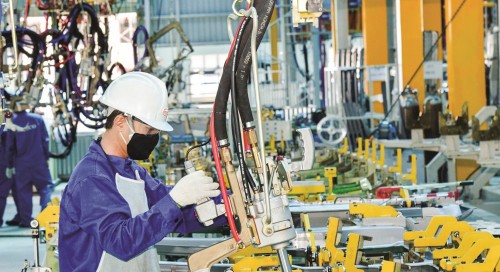 Electronics, computers, mobile phones, and their components enjoy strong growth of 14.3% in the first quarter of 2020. (Photo: congthuong.vn) Electronics, computers, mobile phones, and their components enjoy strong growth of 14.3% in the first quarter of 2020. (Photo: congthuong.vn) |
According to the latest report by the General Statistics Office, the agricultural, forestry, and fishery sectors, already reeling from African swine fever, bird flu, drought, and salt water intrusion, have been further damaged by the COVID-19 pandemic. Their collective growth rate was just 0.08% last quarter.
Industry and construction grew 5.15% overall, but some industries – mine ores, for example – posted negative growth. Manufacturing and processing, on the other hand, grew 7.12%, becoming a leading driver of national economic growth.
Pham Dinh Thuy, Director of the Department of Industrial Statistics of the Ministry of Planning and Investment, highlighted several other bright spots in the economy.
“The most prominent sectors are medicine production, pharmaceutical chemistry, and pharmaceuticals, all of which have seen surges of up to 28.3% against the same period last year due to growing domestic demand and demand for exports,” he said.
“The production and distribution of refined petroleum products also contributed considerably to the state budget. Electronics, computers, mobile phones, and their components enjoyed strong growth of 14.3%,” Thuy added.
Thuy said: “Because of China’s weakened production and the ongoing trade war between the US and China, many countries have started importing electronic components from Vietnam.”
Due to the COVID-19 pandemic, the service sector’s growth was only 3.27% in the first quarter, half the rate in the same period last year. But e-commerce, logistics, and express delivery all recorded strong growth. Preliminary statistics indicate that e-commerce turnover increased 30%, thanks to social distancing recommendations from the government.
Another bright spot of Vietnam’s economy in the first quarter was public investment disbursement. At the end of January, disbursement of investment capital by ministries, sectors, and localities had reached 0.95% of the yearly plan, but by the end of March that figure had risen to 13.2% of plan.
Nguyen Viet Phong, Director of the Department of Construction Statistics and Investment Capital of the General Statistics Office, said the acceleration of disbursement proved the effectiveness of the Government's recent economic decisions.
He attributed the achievement to “a revision of Government policy under which investment capital has been entrusted to localities, ministries, and sectors since the beginning of this year allowing them to play an active role in carrying out their projects.”
Phong said: “In addition, the Investment Law has been revised to simplify investment procedures and enable faster disbursement of public investment. If public investment increases 1%, it adds 0.06% to overall growth, and 1.34% to growth in the construction sector. Public capital has been invested mainly in infrastructure or used as a source of encouragement for other sectors to increase production value.”